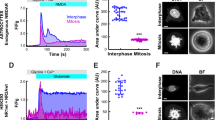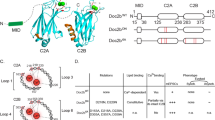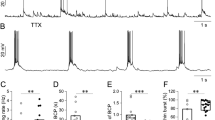Abstract
PROTEIN kinases modulate the activity of several ligand-gated ion channels1, including the NMDA (N-methyl-D-aspartate)2 subtype of glutamate receptor. Although phosphorylation and dephosphorylation of glutamate receptors may participate in several lasting physiological and pathological alterations of neuronal excitability3–7, the physiological control of this cycle for NMDA channels has not yet been established. Using cell-attached recordings in acutely dissociated adult rat dentate gyrus granule cells, we now demonstrate that inhibitors of an endogenous serine/threonine phosphatase prolong the duration of single NMDA channel openings, bursts, clusters and superclusters. Okadaic acid, a non-selective phosphatase inhibitor, prolongs channel openings only at a concentration that inhibits the Ca2+/calmodulin-dependent phosphatase 2B (calcineurin)8, and is ineffective when Ca2+ entry through NMDA channels is prevented. Furthermore, FK506, an inhibitor of calcineurin9,10, mimics the effects of okadaic acid. Thus in adult neurons, calcineurin, activated by calcium entry through native NMDA channels, shortens the duration of channel openings. Simulated synaptic currents11 were enhanced after phosphatase inhibition, which is consistent with the importance of phosphorylation of the NMDA-receptor complex in the short- and long-term control of neuronal excitability.
This is a preview of subscription content, access via your institution
Access options
Subscribe to this journal
Receive 51 print issues and online access
$199.00 per year
only $3.90 per issue
Buy this article
- Purchase on Springer Link
- Instant access to full article PDF
Prices may be subject to local taxes which are calculated during checkout
Similar content being viewed by others
References
Raymond, L. A., Blackstone, C. D. & Huganir, R. L. Trends Neurosci. 16, 147–153 (1993).
Chen, L. & Huang, L.-Y. M. Nature 356, 521–523 (1992).
Bliss, T. V. P. & Collingridge, G. L. Nature 361, 31–39 (1993).
Köhr, G., De Koninck, Y. & Mody, I. J. Neurosci. 13, 3612–3627 (1993).
Figurov, A., Boddeke, H. & Muller, D. Eur. J. Neurosci. 5, 1035–1041 (1993).
Mulkey, R. M., Herron, C. E. & Malenka, R. C. Science 261, 1051–1055 (1993).
Tingley, W. G., Roche, K. W., Thompson, A. K. & Huganir, R. L. Nature 364, 70–73 (1993).
Bialojan, C. & Takai, A. J. Biochem. 256, 283–290 (1988).
Liu, J. et al. Cell 66, 807–815 (1991).
Clipstone, N. A. & Crabtree, G. R. Nature 357, 695–697 (1992).
Edmonds, B. & Colquhoun, D. Proc. R. Soc. 250, 279–286 (1992).
MacDonald, J. F., Mody, I. & Salter, M. W. J. Physiol., Lond. 414, 17–34 (1989).
Gibb, A. J. & Colquhoun, D. J. Physiol., Lond. 456, 143–179 (1992).
Haystead, T. A. J. et al. Nature 337, 78–81 (1989).
Abdul-Ghani, M., Kravitz, E. A., Meiri, H. & Rahamimoff, R. Proc. natn. Acad. Sci. U.S.A. 88, 1803–1807 (1991).
Sah, P., Hestrin, S. & Nicoll, R. A. Science 246, 815–818 (1989).
Mayer, M. L. & Westbrook, G. L. J Physiol., Lond. 394, 501–527 (1987).
Schneggenburger, R., Zhou, Z., Konnerth, A. & Neher, E. Neuron 11, 133–143 (1993).
Legendre, P., Rosenmund, C. & Westbrook, G. L. J. Neurosci. 13, 674–684 (1993).
Rosenmund, C. & Wesbrook, C. L. Neuron 10, 805–614 (1993).
Nowak, L., Bregestovski, P., Ascher, P., Herbert, A. & Prochiantz, A. Nature 307, 462–465 (1984).
Klee, C. B., Draetta, G. F. & Hubbard, M. J. Adv. Enzym. 61, 149–200 (1988).
Steiner, J. P. et al. Nature 358, 584–587 (1992).
Halpain, S. & Greengard, P. Neuron 5, 237–246 (1990).
Goto, S. et al. J. Neurochem. 45, 276–283 (1985).
Polli, J. W., Billingsley, M. L. & Kincaid, R. L. Devl Brain Res. 63, 105–119 (1991).
Watanabe, M., Inoue, Y., Sakimura, K. & Mishina, M. Neuroreport 3, 1138–1140 (1992).
Morioka, M. et al. J. Neurochem. 58, 1798–1809 (1992).
Crepel, V., Hammond, C., Krnjevic, K., Chinestra, P. & Ben-Ari, Y. J. Neurophys. 69, 1774–1778 (1993).
Lester, R. A. J. & Jahr, C. E. J. Neurosci. 12, 635–643 (1992).
Author information
Authors and Affiliations
Rights and permissions
About this article
Cite this article
Lieberman, D., Mody, I. Regulation of NMDA channel function by endogenous Ca2+-dependent phosphatase. Nature 369, 235–239 (1994). https://doi.org/10.1038/369235a0
Received:
Accepted:
Issue Date:
DOI: https://doi.org/10.1038/369235a0
This article is cited by
-
Cellular mechanisms of contextual fear memory reconsolidation: Role of hippocampal SFKs, TrkB receptors and GluN2B-containing NMDA receptors
Psychopharmacology (2024)
-
Alteration in NMDA Receptor Mediated Glutamatergic Neurotransmission in the Hippocampus During Senescence
Neurochemical Research (2019)
-
Presynaptic NMDA receptors control nociceptive transmission at the spinal cord level in neuropathic pain
Cellular and Molecular Life Sciences (2019)
-
Inhibition of Calcineurin A by FK506 Suppresses Seizures and Reduces the Expression of GluN2B in Membrane Fraction
Neurochemical Research (2017)
-
Regulated internalization of NMDA receptors drives PKD1-mediated suppression of the activity of residual cell-surface NMDA receptors
Molecular Brain (2015)
Comments
By submitting a comment you agree to abide by our Terms and Community Guidelines. If you find something abusive or that does not comply with our terms or guidelines please flag it as inappropriate.



